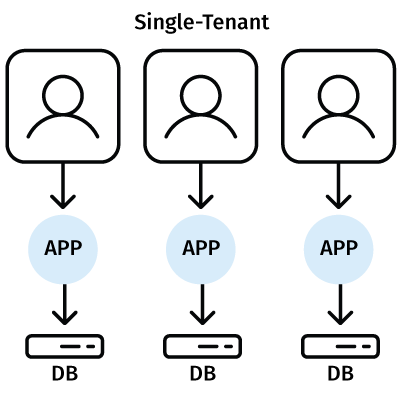Build one SaaS platform to rule them all, with single- and multi-tenant SaaS deployments
Lee James


Recent Posts
Microsoft’s Agentic AI Direction for Enterprise Operations
December 18th, 2025
AI in Financial Services 2025: Turning Intelligence Into Impact
December 15th, 2025
How to Build AI-Enabled Operations and Achieve Measurable Outcomes
December 10th, 2025
Prioritize Strategy to Strengthen Your Cloud Transformation
December 8th, 2025
Modern IT Service Management is Transforming Managed Services - Part 1
December 4th, 2025
Related Posts
AI Insights
Microsoft’s Agentic AI Direction for Enterprise Operations
December 18th, 2025
AI Insights
AI in Financial Services 2025: Turning Intelligence Into Impact
December 15th, 2025
AI Insights
How to Build AI-Enabled Operations and Achieve Measurable Outcomes
December 10th, 2025
Cloud Insights
Prioritize Strategy to Strengthen Your Cloud Transformation
December 8th, 2025
Cloud Insights
Modern IT Service Management is Transforming Managed Services - Part 1
December 4th, 2025
Multi-tenant SaaS delivers cost savings and ease of use. But single-tenant SaaS provides control, security and customization. So offer your customers both.
When you think of software-as-a-service (SaaS), chances are you think “multi-tenant.” And that’s no surprise, since many popular SaaS apps — especially those geared toward SMB and mid-market customers — are often multi-tenant.
Multi-tenant SaaS provides the cost savings and ease of use that many customers want.
But multi-tenant can’t always meet the needs of your entire customer base. Some customers will need the control, security and customization that only single-tenant deployments can provide.
As a result, many software vendors are taking a multi-faceted approach. They’re deploying their software on both multi-tenant and single-tenant architectures. This way, customers get the same pay-for-what-you-use benefits of SaaS, but with the option to choose the level of cost savings and control they need.
So how does this work exactly, and how can it benefit your business? To answer that, let’s first take a step back and define what we mean by “multi-tenant” and “single-tenant” SaaS architecture.
Understanding multi-tenant and single-tenant SaaS architectures
Multi-tenant
With multi-tenant architecture, many customers share one instance of the SaaS application. Each customer’s data is isolated and protected, but the infrastructure itself is shared across all customers.
For the customer, multi-tenant SaaS provides the most cost savings and ease of use. But customers have little control over things like updates, backup and recovery — and customization abilities are limited. Also, with more access points, multi-tenant SaaS can introduce security vulnerabilities.
Single-tenant
With single-tenant architecture, each customer gets their own instance of the SaaS application. The software and data run on infrastructure that’s dedicated to that customer alone — without sharing backend or database resources.
Single-tenant SaaS gives the customer increased security and the freedom to customize the solution. But this also comes at a higher cost and with added responsibilities.
A multi- and single-tenant SaaS deployment example
Let’s say you’re an independent software vendor (ISV). You make and sell software, but your perpetual license model — where users can run (and you have to support) a variety of versions of your software — has been draining your resources. So you’re looking to move your software to the cloud and make it a SaaS offering. This way, you can get everyone running on the same version.
You build out your SaaS solution, deploy it on both multi-tenant and single-tenant architectures and make it available through a subscription model. For the customer, the differences — aside from the inherent multi-tenant/single-tenant strengths and weaknesses noted above — might be around updates, configurations and training. It could look like this, for example:
Updates
- Multi-tenant: Updates are pushed quarterly, with no effort on the customer’s part. But the customer also has no choice about when or whether to get the update.
- Single-tenant: Updates are made available every six months, but customers can defer updates for 12 months. This gives them the flexibility to schedule updates at a time that works for them — to avoid conflicting with, say, a big event.
Configurations
- Multi-tenant: The solution is pre-configured, but the customer can make small tweaks to fit their business needs.
- Single-tenant: The solution comes with customizable modules and pre-configured templates. The customer can’t modify the code, but they can make substantial reconfigurations.
Training
- Multi-tenant: Since the configurations are the same for all customers, end users can take advantage of the provided training and support resources.
-
Single-tenant: The customer will need to provide their own training and support resources, since their solution is unique to them.
With this model, you get all your customers running on the same base version of the software, and they get the deployment that fits them best. This creates operational efficiency for your business, helps you serve your customers more effectively and, ultimately, improves the customer experience.
A real-life success story
Alemba, an enterprise IT service management (ITSM) software provider, transitioned their traditional on-premises solution into a full SaaS platform that can support all their global customers — from SMB to enterprise, across education, healthcare, financial services and government.
Working with Rackspace, Alemba developed an infrastructure capable of offering ITSM templates aimed at smaller businesses (deployed on multi-tenant SaaS), while maintaining the flexibility to develop more bespoke services for larger companies (on single-tenant SaaS).
“We now have a clearly defined, universal offering for customers of all sizes, and we can meet their requirements in a way that’s scalable and sustainable for our own business,” explained Alemba CEO Simon Nugent.
Start your SaaS journey
Are you an ISV looking to transform your business in the cloud? As AWS SaaS Competency Partners, Rackspace and Onica are here to help you design and build your single-tenant and multi-tenant SaaS solutions on AWS.
Don’t go it alone. Our experts can help you leverage all the cloud has to offer, so you can improve operational efficiency, expand market and global reach, increase agility and innovation and obtain economies of scale.
To help you get started, we offer our ISV Cloud Adoption Accelerator Workshop free of charge. It can act as your starting point for your transformation.
Tags:






